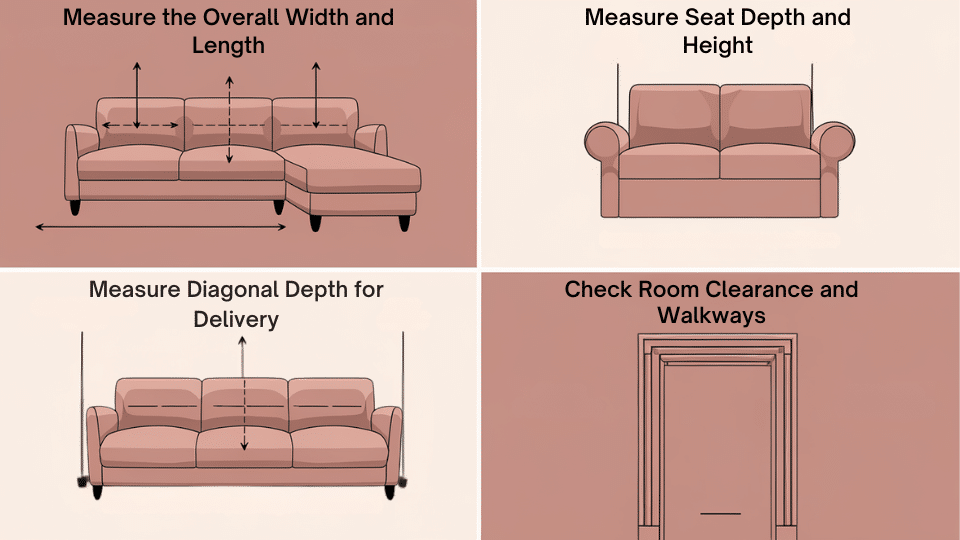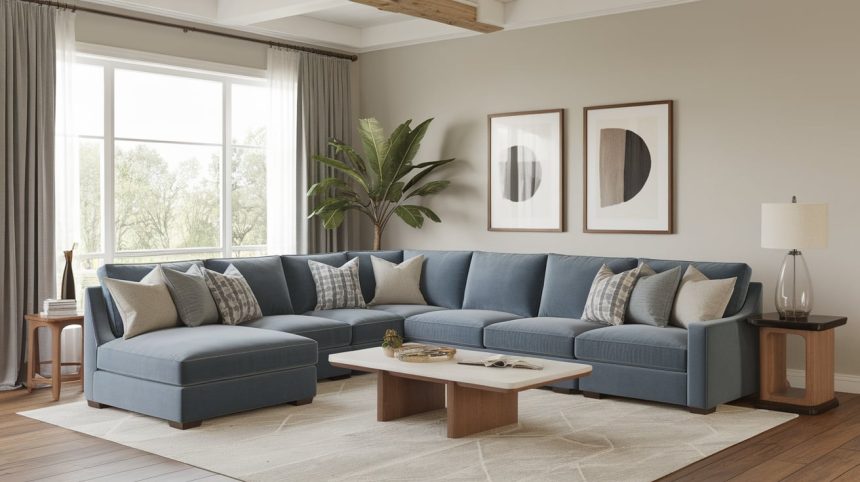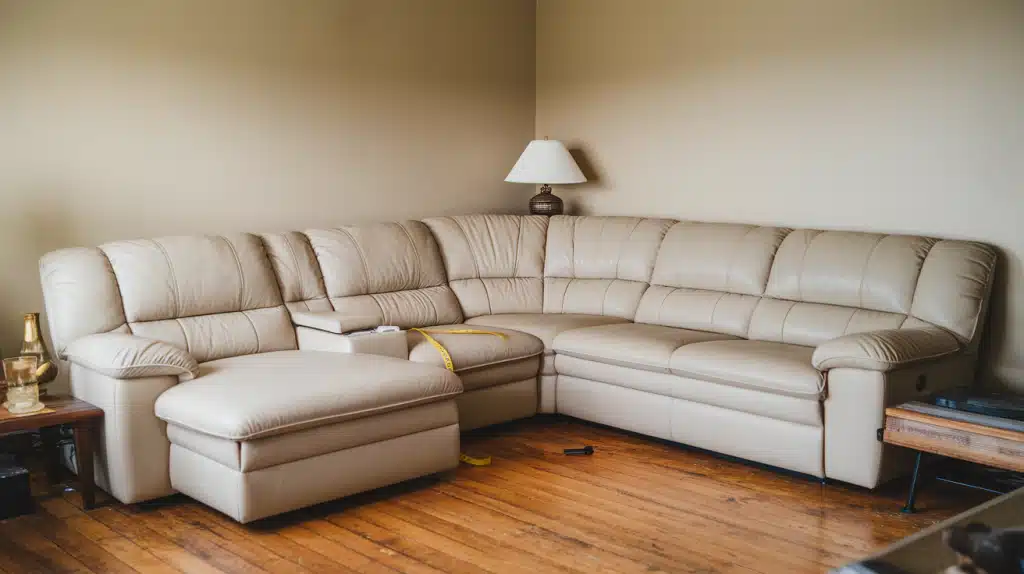Buying a sectional sofa without proper measurements is like playing furniture roulette – and the house always wins. You risk expensive returns, delivery disasters, and living rooms that feel more like obstacle courses than comfortable spaces.
Thousands of homeowners face this exact problem every year, ordering sectionals that don’t fit their rooms, doorways, or lifestyle needs.
The good news? Accurate measuring eliminates these costly mistakes completely. This guide shows you exactly how to measure any sectional configuration, from L-shaped to modular designs. You’ll learn the critical measurements that retailers often overlook and avoid the common errors that lead to furniture disasters.
You’ll get a complete step-by-step system for measuring sectionals like a pro. We’ll cover overall dimensions, delivery requirements, room clearances, and configuration types.
Plus, you’ll learn insider tips for tight spaces and tricky layouts that furniture stores rarely share.
Why Accurate Sectional Sofa Measurements Matter?
Poor measurements create real problems. Your sectional might squeeze into tight corners where no one can sit comfortably. Walking paths get blocked, making your room feel cramped and difficult to navigate.
Some sofas end up so close to the walls that you can’t even vacuum behind them. Different spaces have different challenges. In small apartments, an oversized sectional can make your living room feel like a furniture warehouse.
Studio apartments often suffer when a large sofa dominates the entire space. Large open rooms face the opposite problem – a tiny sectional gets lost and looks out of place.
Furniture returns are expensive and stressful. Most stores charge hefty restocking fees, and you’ll wait weeks for exchanges.
Know Your Sectional Sofa Configuration
Understanding sectional types helps you measure correctly and choose the right fit. Each configuration has different measurement needs and space requirements.
| Configuration | Best For | Key Features | Measurement Focus |
|---|---|---|---|
| L-Shaped | Corner spaces, small to medium rooms | Two perpendicular sections forming an “L” | Width of both arms, corner depth |
| U-Shaped | Large living rooms, family spaces | Three connected sections forming a “U” | Total width, center depth, arm spacing |
| Chaise Lounge | Relaxation, reading nooks | Extended seat for leg support | Chaise length, overall footprint |
| Modular | Flexible layouts, changing needs | Individual pieces that connect | Each module size, total combinations |
| Pit-Style | Entertainment, large families | Low-back, deep seating arrangement | Interior space, entry/exit points |
Step-by-Step Guide: How to Measure a Sectional Sofa

Follow these four essential steps to measure your section accurately and ensure a perfect fit for both your room and delivery path.
Step 1 – Measure the Overall Width and Length
Start with the biggest measurements first. Place your measuring tape at the very tip of one armrest and stretch it to the opposite end. This gives you the total width your sectional will occupy.
Don’t forget chaise extensions and corner pieces. These add significant length to your sofa’s footprint. Measure each section separately, then add them together for your total room requirement.
Key measurement: Record both the main sofa width AND the chaise extension length separately for accurate room planning.
Step 2 – Measure Seat Depth and Height
Seat depth affects comfort and room flow. Measure from the front edge of the seat cushion straight back to where it meets the backrest. Most sectionals range from 20 to 24 inches deep.
Height measurements serve two purposes. Measure from the floor to the seat top (usually 16-20 inches) and floor to the back top. This helps you check if the sofa blocks windows or fits under low ceilings.
Key measurement: Write down seat height, back height, and seat depth – these determine if people can sit comfortably and move around easily.
Step 3 – Measure Diagonal Depth for Delivery
This measurement determines if your sofa fits through doorways. Place a straight edge (like a yardstick) diagonally across your sectional from the highest back corner to the opposite front corner.
Diagonal depth is often the limiting factor for delivery. Even if your sofa fits the room, it might not fit through your front door, stairwell, or elevator. This measurement prevents delivery day disasters.
Key measurement: Compare your diagonal measurement to your narrowest doorway – it must be at least 2-3 inches smaller than your door opening.
Step 4 – Check Room Clearance and Walkways
Plan for comfortable movement around your sectional. Leave 30-36 inches of clear walkway space on all sides where people need to pass. Tight spaces feel cramped and limit furniture use.
Factor in your other furniture pieces. Coffee tables need 12-18 inches from the sofa edge. Side tables require 6-12 inches of clearance. Area rugs should extend 6-8 inches beyond the sofa on all sides.
Key measurement: Map out your entire room layout on paper, including all furniture pieces and their required clearance zones.
Measuring for Custom or Modular Sectionals
- Modular sectionals require a different measuring approach. You need to measure both individual modules and potential combined configurations. This flexibility comes with extra planning requirements.
- Measure each module separately first. Record the width, depth, and height of every piece, including corner units, armless chairs, ottomans, and chaise sections. Label each measurement clearly, as modules often resemble one another but have distinct dimensions.
- Plan multiple layout options from the start. Modular sectionals shine when you can rearrange them for different occasions or room changes. Measure your space for at least two to three different configurations to determine which arrangements work best.
- Consider future expansion possibilities. Many people start with a basic L-shape and add pieces later. Measure where additional modules could be placed and ensure your room can accommodate growth. Verify that doorways can accommodate additional pieces for future deliveries.
- Account for connection hardware space. Modular pieces need small gaps between sections for connecting brackets or clips. Add 1-2 inches to your total measurements when modules connect to avoid tight fits.
- Test your most compact and largest configurations. Measure your room for both the smallest arrangement (for tight gatherings) and the maximum expanded setup (for big family events). This ensures your modular sectional adapts to all your needs.
Mistakes to Avoid When Measuring a Sectional
| Mistake | Why It’s a Problem | Pro Tip |
|---|---|---|
| Skipping Doorway Checks | The sofa may not fit through doors, stairs, or halls | Measure diagonal depth and access paths |
| Ignoring Armrest Height | Can block windows or stop wall placement | Measure the floor to the armrest top |
| Forgetting Ottomans/Recliners | Extra pieces need more space | Include full extension in the layout |
| Wrong Chaise Orientation | Left/right facing can clash with the layout | Confirm LHF or RHF with diagrams |
| Not Marking the Floor | Hard to visualize the actual footprint | Use painter’s tape to outline the shape |
Digital Tools for Measuring Sectionals
- Roomstyler: Free 3D room designer that lets you test different sectional layouts before you buy.
- MagicPlan: Uses your phone camera to create accurate floor plans and furniture placement guides.
- Planner 5D: Drag-and-drop room planner with thousands of furniture options, including sectional sofas.
Conclusion
Measuring your sectional sofa correctly saves you money, time, and major headaches. You now know how to calculate overall dimensions, seat depth, diagonal delivery requirements, and room clearances.
These skills prevent the expensive mistakes that trap thousands of furniture buyers every year.
Smart measuring means confident shopping. No more wondering if that beautiful sectional will actually fit your space. No more surprise delivery day disasters or costly return fees. You have the tools to choose sectionals that work perfectly in your room.
Ready to start measuring? Grab your measuring tape and use this guide to find your ideal sectional sofa. Your future self will thank you for doing the homework upfront.
What’s your biggest concern about measuring a sectional? Share your questions in the comments below. We’d love to help you create the perfect living space.
Frequently Asked Questions
How to Measure for a Sectional Couch?
Measure overall width, length, seat depth, back height, and diagonal depth for delivery clearance.
How to Measure the Size of an L-Shaped Sofa?
Measure each arm of the “L” separately, then record the corner depth and total footprint dimensions.
How Do you measure the Length of a Sofa?
Measure from the outside edge of one armrest to the outside edge of the opposite armrest.
What Is the Average Size of a Sectional in Feet?
Most sectionals range from 6-10 feet long and 3-4 feet deep, depending on configuration and seating capacity.


